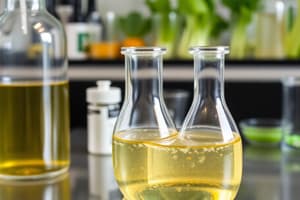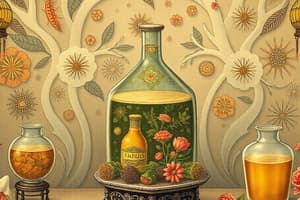Podcast
Questions and Answers
Microbes are classified based on their:
Microbes are classified based on their:
- Nitrogen source
- Energy source
- Electron source
- Carbon source (correct)
Heterotrophs use CO2.
Heterotrophs use CO2.
False (B)
What are carbons used to make?
What are carbons used to make?
Precursor metabolites
What two things are needed to make precursor metabolites, and to assemble them into macromolecules?
What two things are needed to make precursor metabolites, and to assemble them into macromolecules?
Microbes can be classified based on their energy source. What are 'chemotrophs'?
Microbes can be classified based on their energy source. What are 'chemotrophs'?
Microbes can be classified based on their electron source. What are 'organotrophs'?
Microbes can be classified based on their electron source. What are 'organotrophs'?
Which of the following is a macronutrient?
Which of the following is a macronutrient?
Most bacteria on the human body are chemoorganoheterotrophs.
Most bacteria on the human body are chemoorganoheterotrophs.
What is the first step of aerobic respiration?
What is the first step of aerobic respiration?
What is the most common glycolytic pathway?
What is the most common glycolytic pathway?
What enzyme complex converts pyruvate into acetyl-CoA?
What enzyme complex converts pyruvate into acetyl-CoA?
What is the final electron acceptor in anaerobic respiration?
What is the final electron acceptor in anaerobic respiration?
What needs to be regenerated in fermentation?
What needs to be regenerated in fermentation?
Sulfa drugs inhibit which of the following?
Sulfa drugs inhibit which of the following?
Diffusion mechanisms require an input of energy.
Diffusion mechanisms require an input of energy.
Match the following:
Match the following:
In gram-negative bacteria, is SBP in periplasm or cytoplasm?
In gram-negative bacteria, is SBP in periplasm or cytoplasm?
Gram-negative outer membranes contain what?
Gram-negative outer membranes contain what?
What is the function of TonB?
What is the function of TonB?
Flashcards
Heterotrophs
Heterotrophs
Organisms that use organic molecules as a carbon source.
Autotrophs
Autotrophs
Organisms that use CO2 as a carbon source.
Precursor Metabolites
Precursor Metabolites
Simple organic molecules that are intermediates in metabolic pathways, used to build complex molecules.
Chemotrophs
Chemotrophs
Signup and view all the flashcards
Phototrophs
Phototrophs
Signup and view all the flashcards
Electron Source
Electron Source
Signup and view all the flashcards
Organotrophs
Organotrophs
Signup and view all the flashcards
Lithotrophs
Lithotrophs
Signup and view all the flashcards
Electron Acceptor
Electron Acceptor
Signup and view all the flashcards
Macronutrients
Macronutrients
Signup and view all the flashcards
Micronutrients
Micronutrients
Signup and view all the flashcards
Aerobic Respiration
Aerobic Respiration
Signup and view all the flashcards
Anaerobic Respiration
Anaerobic Respiration
Signup and view all the flashcards
Fermentation
Fermentation
Signup and view all the flashcards
Embden-Meyerhof Pathway
Embden-Meyerhof Pathway
Signup and view all the flashcards
Entner-Doudoroff Pathway
Entner-Doudoroff Pathway
Signup and view all the flashcards
Pentose Phosphate Pathway
Pentose Phosphate Pathway
Signup and view all the flashcards
Pyruvate Dehydrogenase Complex
Pyruvate Dehydrogenase Complex
Signup and view all the flashcards
Tricarboxylic Acid (TCA) Cycle
Tricarboxylic Acid (TCA) Cycle
Signup and view all the flashcards
Electron Transport Chain (ETC)
Electron Transport Chain (ETC)
Signup and view all the flashcards
Ubiquinone (Coenzyme Q)
Ubiquinone (Coenzyme Q)
Signup and view all the flashcards
Cytochromes
Cytochromes
Signup and view all the flashcards
Proton Motive Force (PMF)
Proton Motive Force (PMF)
Signup and view all the flashcards
ATP Synthase
ATP Synthase
Signup and view all the flashcards
Sulfa Drugs
Sulfa Drugs
Signup and view all the flashcards
Trimethoprim
Trimethoprim
Signup and view all the flashcards
Active Transport
Active Transport
Signup and view all the flashcards
ATP-Binding Cassette (ABC) Transporters
ATP-Binding Cassette (ABC) Transporters
Signup and view all the flashcards
Solute-Binding Proteins (SBPs)
Solute-Binding Proteins (SBPs)
Signup and view all the flashcards
Group Translocation
Group Translocation
Signup and view all the flashcards
Study Notes
- Lecture topic is Metabolism and Nutrient Transport
Lecture Learning Outcomes
- Describe the different carbon, energy, and electron sources used by bacteria
- Describe the general steps of aerobic respiration, anaerobic respiration, and fermentation
- Explain why bacterial metabolism is a difficult antibiotic target, and how sulfa drugs and trimethoprim work
- Describe the different uptake systems used by bacteria to allow nutrients through the cytoplasmic and outer membranes
Carbon
- Cells are mainly built from organic molecules, specifically carbon backbones
- Microbes are classified based on their carbon source
- Heterotrophs use organic carbon molecules
- Autotrophs use CO2 as a carbon source
- Carbons are used to make precursor metabolites, which are simple organic molecules
- Precursor metabolites are intermediates in metabolic pathways
- Precursor metabolites are used to build more complex organic molecules
Building a Bacterium
- Energy and electrons are needed to make precursor metabolites
- Energy and electrons are needed to assemble precursor metabolites into macromolecules like proteins and nucleic acids
Energy and ATP
- Energy powers chemical processes
- Energy is needed for transport, like importing nutrients, and mechanical work like flagellar rotation
- Microbes are classified based on their energy source
- Chemotrophs use organic or inorganic molecules
- Phototrophs use light
- Energy from an energy source is commonly conserved in the form of ATP
Reducing Power (Electrons)
- Building some organic molecules requires reducing power
- Reducing power can be used to make ATP via the electron transport chain
- Microbes are also classified based on their electron source:
- Organotrophs use reduced organic molecules
- Lithotrophs use reduced inorganic molecules
- Electrons are funneled to electron carriers NAD+ and FAD
- This makes NADH and FADH2, which are reduced forms of the electron carriers
Other Nutrients
- Elements besides carbon are needed for cell function
- Macronutrients are needed in large amounts
- These include C, O, H, N, S, and P
- They are the building blocks (amino acids, etc)
- K, Ca, Mg, and Fe, as cations and co-factors
- They stabilize cellular structures like the cell wall
- Micronutrients are needed in small amounts
- They are also known as trace elements
- Co, Cu, Mo, Mn, Zn, and Ni are cations and co-factors
Microbial Metabolism
- Most bacteria on the human body are chemoorganoheterotrophs
- These bacteria get their carbon, energy, and electrons from organic molecules
- ATP is made by oxidizing reduced organic molecules, such as through:
- Aerobic respiration
- Anaerobic respiration
- Fermentation
- ATP can be generated with an electron transport chain
- This is part of aerobic and anaerobic respiration
Aerobic Respiration
- During aerobic respiration, energy is conserved as ATP, and electrons are collected in NADH and FADH2 forming precursor metabolites
- Glycolytic pathways (glycolysis) oxidize glucose to make pyruvate, ATP, and NADH
- The tricarboxylic acid (TCA) cycle oxidizes acetyl-CoA to produce CO2, ATP, NADH, and FADH2 Electrons from NADH and FADH2 are used in the electron transport chain (ETC) to generate more ATP
Glycolytic Pathways
- Embden-Meyerhof pathway
- This is the most common pathway and is also found in animals
- Makes pyruvate, ATP, and NADH
- Entner-Doudoroff pathway
- Occurs in some bacteria
- Makes glyceraldehyde 3-phosphate (G3P), pyruvate, and NADPH
- G3P enters the Embden-Meyerhof pathway
- Pentose phosphate pathway
- Often used for biosynthesis
- Makes NADPH
- Makes precursor metabolites for nucleotides and amino acids
Tricarboxylic Acid Cycle
- The pyruvate dehydrogenase complex converts pyruvate into acetyl-CoA
- Acetyl-CoA then enters the tricarboxylic acid (TCA) cycle
- Acetyl-CoA is oxidized, producing CO2, GTP (ATP), NADH, and FADH2
- Some intermediates from the TCA cycle are used as precursor metabolites
Electron Transport Chain (ETC)
- Electrons in NADH and FADH2 are used to make more ATP
- These electrons are transferred to membrane-bound electron carriers
- Ubiquinone, also known as coenzyme Q (CoQ)
- Cytochromes made from proteins with heme co-factors
- A Lower redox potential means a greater likelihood of giving up electrons
- Each carrier is reduced by the preceding carrier and oxidized by the following carrier
- There are increasing redox potentials in the electron transport chain
Electron Transport Chain in E. coli
- Electrons are transferred from NADH to ubiquinone (Q)
- Electrons pass through a series of cytochromes and the terminal electron acceptor
- For example, b562 and o
- Aerobic respiration uses O2 as a terminal electron acceptor
- Electron transfers drive the transport of protons into the periplasm, generating a proton-motive force (PMF)
Proton Motive Force and ATP Synthase
- PMF refers to potential energy due to proton and charge gradient across a membrane
- Cytoplasm is relatively alkaline and negatively charged
- Protons flow down the concetration gradient into the cytoplasm
- Protons travel through ATP synthase to make ATP
Anaerobic Respiration
- Similar to aerobic respiration, including glycolysis, TCA cycle, and ETC
- Also makes ATP, NADH, and FADH2, but the terminal electron acceptor is not O2
- Instead, nitrate, sulfate, and CO2 are the final electron acceptor
- Paracoccus denitrificans reduces nitrate to N2
Fermentation
- Some bacteria lack or repress an ETC, meaning NADH has to be used for something other than energy production
- Fermentation is a pathway by which a substrate is partially oxidized, such as by glycolysis
- The process makes ATP
- There is no ETC and no exogenous electron acceptor
- Electrons are transferred from NADH to pyruvate or a pyruvate derivative
- This process regenerates NAD+
Bacterial Metabolism and Antibiotics
- Humans are chemoheterotrophs
- Human microbiota are chemoheterotrophs, using our food and us as nutrients
- Humans and human microbiota use similar metabolic pathways
- It is difficult to selectively target bacterial metabolic enzymes
- This creates a toxicity concern
Tetrahydrofolate Synthesis
- Tetrahydrofolate is a cofactor
- Needed to make purines and pyrimidines (DNA/RNA), and methionine (amino acid)
- Humans acquire folates from diet (vitamin B9)
- Some bacteria have to make their own tetrahydrofolate
- Folate biosynthetic enzymes are therefore antibiotic targets
Sulfa Drugs and Trimethoprim
- Sulfa drugs (e.g., SMX) inhibit dihydropteroate synthase
- They resemble p-aminobenzoic acid and act as competitive inhibitors
- Trimethoprim inhibits dihydrofolate reductase, resembling dihydrofolic acid
- Blocking tetrahydrofolate production inhibits bacterial growth
- Combination of sulfa drugs and trimethoprim is often used for synergistic effect (e.g., TMP/SMX)
Nutrient Uptake
- Nutrients must be collected from environment
- Often limited abundance, leading to competition
- Cell envelope is a good barrier, but hydrophilic nutrients can't pass through
- Protein channels and transporters are thus often needed
Energy Independent Transport
- Diffusion mechanisms do not require an input of energy
- Substances move down a concentration gradient
- Not very useful, as concentration is usually lower outside of the cell
- Some substances diffuse across the cytoplasmic membrane, others through carrier proteins
Primary Active Transport
- Active transport involves moving substances against their concentration gradient, requiring energy input
- Primary active transporters use energy from ATP hydrolysis
- ATP-binding cassette (ABC) transporters are common primary active transporters in bacteria
- Importers are used for sugars and other nutrients
- Exporters expel substances from the cell
ABC Transporter Solute Binding Proteins
- Most ABC transporters work with solute-binding proteins (SBPs)
- SBPs deliver a specific substrate to the transporter
- In Gram-negatives, SBP is in the periplasm
- In Gram-positives, SBP is lipoprotein or is associated with PG
Secondary Active Transport
- Potential energy from an ion gradient can power the transport of a substance against its concentration gradient
- The ion gradient generation includes the electron transport chain (PMF)
- The ion gradient can also stem from V-type ATPases
- Energy from ATP hydrolysis creates a H+ or Na+ gradient
- This reverses ATP synthase
- Other ion gradients
- E.g., H+/Na+ antiporter
Secondary Active Transport
- H+/Na+ antiporter is a form of secondary active transport
- ETC generates a proton motive force (PMF)
- Transport of H+ down its gradient powers the export of Na+ up its gradient via the antiporter
- The new Na+ gradient then powers the Na+/nutrient symporter
Group Translocation
- This is an active transport process where the substrate is chemically modified
- An example is the sugar phosphotransferase system (PTS)
- Sugars are transported across the cytoplasmic membrane and are phosphorylated during transport
- Phosphate from phosphoenolpyruvate (PEP) is transferred to PTS components, then to the sugar
Outer Membrane Transport
- The Gram-negative outer membrane contains porins
- These are beta-barrel proteins
- Solutes travel through porins to reach the periplasm, allowing for diffusion
- This process cannot directly concentrate substrates
- The size of the water-filled channel determines which substrates enter
- Some porins have substrate-binding sites, which helps attract certain substrates to the porin
Porins and Antibiotic Resistance
- Lack of specificity can be detrimental, for example, with antibiotics
- Mutations to porin genes can confer antibiotic resistance
- Changes to number and/or structure of porins
- Porin loss exerts a fitness cost
- Decreases nutrient uptake
- Impairs membrane structure
TonB-Dependent Receptors
- These are active transporters in the outer membrane
- They contain Beta-Barrel proteins
- The channel is blocked by a plug
- Substrate specific and substrate binding exposes the TonB box
- The TonB box binds to TonB
- TonB pulls out the plug, and the substrate id transported
- Energy is provided by PMF
Iron and Siderophores
- Bacteria need iron for cytochromes (ETC) and enzyme co-factors
- Ferric iron (Fe3+) is very insoluble, limiting its availability
- Bacteria scavenge iron using siderophores
- E.g., enterobactin
- Binds very tightly to Fe3+
- Siderophores are released into the environment, where they compete for Fe3+
Iron and Siderophores
- Fe3+ must then reach the cytoplasm
- There are different paths to do this
- Secreted siderophore binds to Fe3+
- Transports to periplasm by TonB-dependent receptor
- Then binds to periplasmic SBP
- Next delivered to the ABC transporter
- Where the siderophore-Fe3+ complex is transported to cytoplasm
Studying That Suits You
Use AI to generate personalized quizzes and flashcards to suit your learning preferences.




